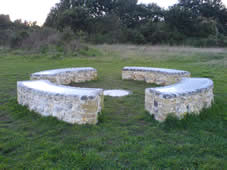anita rivera : maidscross
|
|
|
anita rivera : maidscross
Lakenheath local nature reserve 2005


Inspiration for the design of the seating at Maidscross Hill was drawn from site visits and conversationswith Local Nature Reserves Officer, Cyd Worden and from research into the historical context of the site and the surrounding area. As the Brecks is so rich in history, I decided that the design should include a deliberate juxtaposition of ancient and modern building techniques and that I would like, wherever possible, to use reclaimed or recycled materials. An advantage of Maidscross is the exposed nature of the landscape and extraordinary vistas with uncluttered skyline enabling maximum filtration of the sun. I chose stainless steel as it reflects the environment and because I could inscribe it with text, which would react with the sunlight. Flint has been used in the Brecks as a building material for centuries so it seemed fittingthat I should incorporate it into the design.
Aware that there used to be a cross on top of Maidscross Hill, but not having any pictures, I began looking at the design of ancient crosses in an effort to comprehend what the original cross may have looked like. The form of the Celtic cross in particular appealed to me because of its ambiguity, being multi faith, and as a symbolic reference to Celtic History. The seats represent the outer circle of the cross and the cross itself is implied in the negative space between the segments. The central circle denotes the sun and is inscribed with directional information.It was important to me that the users of the site should also be involved in the design in some meaningful way so local people have contributed to the content of the text inscribed upon the steel by sending in poems and reminiscences relating to Maidscross and Lakenheath. The text is intended as an interpretation of the
site and also features references to the biological diversity of the Local Nature Reserve. People in the surrounding area have contributed stones and flint, which were used in the seat’s construction. As the name Maidscross is apparently derived from historical reference to the maids who carried crosses in religious ceremony I wanted as many women as possible to participate in the making of the cross in some way so on site workshops were also set up with local girl guides giving access to the artist’s creative process whilst gleaning more text for the seating. Local women have written the majority of the poetry inscribed upon the seats. Cyd Worden and I also assisted in the fabrication of the flint wall, which was
carried out by John Neville & Son. Installation was implemented by Steve Waldman, Anita Rivera, Guy Belcher and Nick Wyatt. I inscribed and fabricated the stainless steel myself.
site is under construction, so some links and pages may not work, please check back soon